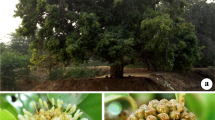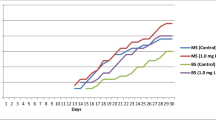Abstract
Picconia azorica (Tutin) Knobl. (Oleaceae) is a woody plant endemic from the Azores. It is considered as a part of a true relict taxon, reflecting its phylogeny, genetics and geography. Given the fragile status of this species, effective management and conservation are necessary for its survival and repopulation, initially for ecological reasons, but ultimately for forestry purposes as a valuable source of timber. Micropropagation is a useful tool for conservation programs, and in vitro culture techniques have, therefore, been developed for P. azorica by testing different combinations of media and growth regulators at each micropropagation stage. Adult plants from the field were successfully established in vitro on Rugini olive medium supplemented with 24.6 µM 2-isopentenyl adenine (2iP), resulting in 91.2 % sprouting of the nodal explants that survived the disinfection stage, although similar results were achieved using 18.2 µM zeatin. At the multiplication stage, the best shoot quality and the best compromise between shoot length and new axillary shoot development were achieved using the modified macronutrients Driver and Kuniyuki walnut medium supplemented with 24.6 µM 2iP and 0.6 µM indole-3 acetic acid. Rooting was most successful with half-strength macronutrients combined with 10 µM indole-3 butyric acid. Using this micropropagation protocol, a wide range of accessions were successfully established in vitro and are now being propagated on a larger scale for ecosystem restoration.




Similar content being viewed by others
References
Brito G, Santos C (2009) Basal medium improvement for routine micropropagation of Olea maderensis: physiological comparative studies. Can J For Res 39:814–822. doi:10.1007/s00468-009-0344-x
Brochard P (1991) Use of artificial substrates for in vitro propagation. In: Bajaj YPS (ed) Biotechnology in agriculture and forestry, high-tech and micropropagation, vol I. Springer, Berlin, pp 270–284
Cardoso P, Borges PAV, Costa AC, Cunha RT, Gabriel R, Martins AMF, Silva L, Homem N, Martins M, Rodrigues P, Martins B, Mendonça E (2008) A perspectiva arquipelágica—Açores. In: Martín JL, Arechavaleta M, Borges PAV, Faria B (eds) TOP 100—As cem espécies ameaçadas prioritárias em termos de gestão na região europeia biogeográfica da Macaronésia. Consejería de Medio Ambiente y Ordenación Territorial, Gobierno de Canarias, pp 421–449
Cozza R, Turco D, Batti CB, Bitonti MB (1997) Influence of growth medium on mineral composition and leaf histology in micropropagated plantlets of Olea europaea. Plant Cell Tissue Org 51:215–223. doi:10.1023/A:1005966404642
Driver J, Kuniyuki A (1984) In vitro propagation of Paradox walnut rootstock. HortScience 19:507–509
Ďurkovič J, Mišalová A (2008) Micropropagation of temperate noble hardwoods: an overview. Funct Plant Sci Biotechnol 2:1–19
Ferreira M, Eriksson G (2006) A programme for the management of forest tree genetic resources in the Azores islands. Silva Lus 14:59–73
Flora LL, Madore MA (1993) Stachyose and mannitol transport in olive (Olea europaea L.). Planta 189:484–490
Frutuoso G (1583) Saudades da Terra. Ponta Delgada, Azores, Portugal
García JL, Troncoso J, Sarmiento R, Troncoso A (2002) Influence of carbon source and concentration on the in vitro development of olive zygotic embryos and explants raised from them. Plant Cell Tissue Org 69:95–100. doi:10.1023/A:1015086104389
Hammatt N, Ridout MS (1992) Micropropagation of common ash (Fraxinus excelsior). Plant Cell Tissue Org 13:67–74. doi:10.1007/BF00043477
IUCN 2013. IUCN red list of threatened species. Version 2013.1. www.iucnredlist.org. Accessed 05 July 2013
Lambardi M, Rugini E (2003) Micropropagation of olive (Olea europaea L.). In: Jain SM, Ishii K (eds) Micropropagation of woody trees and fruits. Kluwer Academic Publishers, Dordrecht, pp 621–646
Lambardi M, Ozudogru E-A, Roncasaglia R (2013) In vitro propagation of olive (Olea europaea L.) by nodal segmentation of elongated shoots. In: Lambardi M, Ozudogru E-A, Jain S-M (eds) Protocols for micropropagation of selected economically-important horticultural plants, Methods in Molecular Biology 994. Springer, New York, pp 33–44
Leva AR, Petruccelli R, Bartolini G (1994) Mannitol in vitro culture of Olea europaea L. (cv Maurino). Acta Hortic 356:43–46
Leva AR, Sadeghi H, Petruccelli R (2013) Carbohydrates modulate the in vitro growth of olive microshoots I: the analysis of shoot growth and branching patterns. J Plant Growth Regul 32:53–60. doi:10.1007/s00344-012-9275-7
Loberant B, Altman A (2010) Micropropagation of plants. In: Flickinger MC (ed) Encyclopedia of industrial biotechnology: bioprocess, bioseparation, and cell technology. Wiley, New York, pp 3499–3515
Lopes MS, Mendonça D, Bettencourt S, Borba AR, Melo C, Baptista C, da Câmara Machado A (2014) Genetic diversity of an Azorean endemic and endangered plant species inferred from ISSR markers. AoB Plants plu034. doi:10.1093/aobpla/plu034
Lucchesini M, Mensuali-Sodi A (2004) Influence of medium composition and vessel ventilation on in vitro propagation of Phillyrea latifolia L. Sci Hortic 100:117–125. doi:10.1016/j.scienta.2003.07.005
Martins FEO (1981) Mobiliário Açoriano, elementos para o seu estudo. Região Autónoma dos Açores, Secretaria Regional da Educação e Cultura, Direcção Regional dos Assuntos Culturais, Angra do Heroísmo, Portugal
Murashige T, Skoog F (1962) A revised medium for rapid growth and bioassays with tobacco tissue culture. Physiol Plant 15:473–497
Oddo E, Saiano F, Alonzo G, Bellini E (2002) An investigation of the seasonal pattern of mannitol content in deciduous and evergreen species of the Oleaceae growing in northern Sicily. Ann Bot Lond 90:239–243. doi:10.1093/aob/mcf177
Peixe A, Raposo A, Lourenço R, Cardoso H, Macedo E (2007) Coconut water and BAP successfully replaced zeatin in olive (Olea europaea L.) micropropagation. Sci Hortic 113:1–7. doi:10.1016/j.scienta.2007.01.011
Peltier JP, Marigo D, Marigo G (1997) Involvement of malate and mannitol in the diurnal regulation of the water status in members of Oleacea. Trees 12:27–34. doi:10.1007/s004680050118
Perez-Parron MA, Gonzalez-Benito ME, Perez C (1994) Micropropagation of Fraxinus angustifolia from mature and juvenile plant material. Plant Cell Tissue Org 37:297–302. doi:10.1007/BF00042343
Reed BM, Sarasan V, Kane M, Bunn E, Pence VC (2011) Biodiversity conservation and conservation biotechnology tools. In Vitro Cell Dev Plant 47:1–4. doi:10.1007/s11627-010-9337-0
Reed BM, Wada S, DeNoma J, Niedz RP (2013) Improving in vitro mineral nutrition for diverse pear germplasm. In Vitro Cell Dev Plant 49:343–355. doi:10.1007/s11627-013-9504-1
Revilla MA, Pacheco J, Casares A, Rodriguez R (1996) In vitro reinvigoration of mature olive trees (Olea europaea L.) through micrografting. In Vitro Cell Dev Plant 32:257–261. doi:10.1007/BF02822697
Rugini E (1984) In vitro propagation of some olive (Olea europaea L.) cultivars with different root ability, and medium development using analytical data from developing shoots and embryos. Sci Hortic 24:123–134. doi:10.1016/0304-4238(84)90143-2
Santos C, Brito G, Pinto G, Fonseca H (2003) In vitro plantlet regeneration of Olea europaea ssp. maderensis. Sci Hortic 97:83–87. doi:10.1016/S0304-4238(02)00148-6
Sarasan V, Cripps R, Ramsay MM, Atherton C, McMichen M, Prendergast G, Rowntree JK (2006) Conservation in vitro of threatened plants—progress in the past decade. In Vitro Cell Dev Plant 42:206–214. doi:10.1079/IVP2006769
Schäfer H (2002) Flora of the Azores: a field guide. Margraf Verlag, Weikersheim
Stoop JMH, Williamson JD, Pharr DM (1996) Mannitol metabolism in plants: a method for coping with stress. Trends Plant Sci 1:139–144. doi:10.1016/S1360-1385(96)80048-3
Van Sambeek JW, Preece JE (2007) In vitro propagation of Fraxinus species. In: Jain SM, Häggman H (eds) Protocols for micropropagation of woody trees and fruits. Springer, Netherlands, pp 179–192
Vargas P (2007) Are Macaronesian islands refugia of relict plant lineages? A molecular survey. In: Weiss SJ, Ferrandeds N (eds) Phyleogeography in Southern European refugia: evolutionary perspectives on the origins and conservation of European biodiversity. Springer, Berlin, pp 297–314
Zacchini M, De Agazio M (2004) Micropropagation of a local olive cultivar for germplasm preservation. Biol Plant 48:589–592. doi:10.1023/B:BIOP.0000047156.57328.27
Zuccherelli G, Zuccherelli S (2002) In vitro propagation of fifty olive cultivars. Acta Hortic 586:931–934
Acknowledgments
This project was supported by the Azorean Government (Secretary for Natural Resources). CBA was supported by the Portuguese Foundation for Science and Technology (FCT, PEst-OE/EQB/LA0023/2013) and the Azorean Regional Science Fund (FRC). The following authors were supported by FRC: DM (M317/F/010A/2009), SL (M3.1.2/F/041/2011), SB (M3.1.7/F/026/2011) and MSL (M3.1.7/F/023/2011). The authors thank Richard M. Twyman for editing the article.
Author information
Authors and Affiliations
Corresponding author
Additional information
Communicated by M. Lambardi.
Rights and permissions
About this article
Cite this article
Mendonça, D., Luna, S., Bettencourt, S. et al. In vitro propagation of Picconia azorica (Tutin) Knobl. (Oleaceae) an Azorean endangered endemic plant species. Acta Physiol Plant 37, 47 (2015). https://doi.org/10.1007/s11738-015-1797-8
Received:
Revised:
Accepted:
Published:
DOI: https://doi.org/10.1007/s11738-015-1797-8




